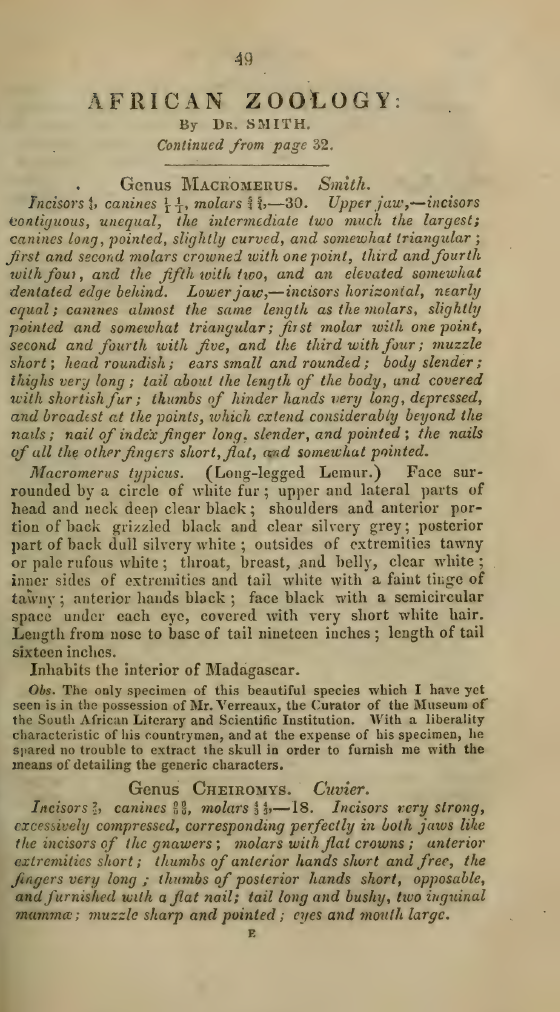African zoology
DOI:
https://doi.org/10.21504/saqj.21.2694Keywords:
African Mammalogy, Prosimian Taxonomy, Animals -- Dental Formula, Madagascar Fauna, Cheiroptera, Insectivora, 19th-century zoology, African ZoologyAbstract
This second instalment (see https://doi.org/10.21504/saqj.21.2691 for the first part) of Dr Smith's "African Zoology" provides detailed taxonomic descriptions for numerous species of mammals, divided into three orders: Quadrumana (Primates/Lemurs), Cheiroptera (Bats), and Feral (represented here by Insectivora).
Order Quadrumana (Primates/Lemurs):Dr Smith establishes three new or detailed genera primarily from Madagascar, emphasising their distinct dental formulas, which are provided using precise numerical notation (e.g., incisors, canines, molars).
- Genus Macromerus (Smith, new genus): Defined by a specific dental formula (i44,c11,m55 total 30) and unique physical traits, notably very long thighs and specialised finger nails (flat and pointed, except for the long, slender nail of the index finger).
- Macromerus typicus (Long-legged Lemur): Described as a beautiful species found in the interior of Madagascar, distinguished by its white facial circle contrasting with deep, clear black and silvery grey fur on the body.
- Genus Cheiromys (Cuvier): Characterised by strong, compressed incisors (i22,c00,m44 total 18) and a long, bushy tail.
- Cheiromys Madagascariensis (The Aye Aye): A ferruginous brown creature with a long tail, also confirmed to inhabit Madagascar.
- Genus Cheirogaleus (Geoffroy): Defined by a complex six-molar dentition (i44,c11,m66 total 36) and a rounded head with eyes approaching.
- Cheirogaleus typicus and other species are detailed as inhabiting Madagascar.
The text then moves to the Order Cheiroptera (Bats), defined by their large, membrane-supported wings. Descriptions are given for numerous species across multiple genera, differentiating them by their dental formulas, nasal appendages, ears, and tail structure (presence/absence of a tail or how much it is enveloped by the interfemoral membrane).
- Genus Pteropus (Rousettes/Flying Foxes): Large bats, mostly tailless, including Pteropus Edwardii (Madagascar) and Pteropus Leachii (South Africa).
- Genus Nyctinomus: Characterised by a long tail extending beyond the interfemoral membrane. Includes species from Egypt and South Africa (e.g., Nyctinomus Condylurus found near Port Natal).
- Genus Rhinolophus: Noted for the nasal crest or leaf, including Rhinolophus clivosus, found commonly near Cape Town.
- Genus Vespertilio (Common Bats): Large section detailing numerous species, including several described by Smith from the Cape Colony and Natal (e.g., Vespertilio Capensis, Vespertilio Hottentota, Vespertilio Dinganii).
The survey briefly concludes with the Family Insectivora, specifically the genus Erinaceus.
- Genus Erinaceus (Hedgehog):
- Erinaceus frontalis (Cape Hedgehog): A South African species distinguished by its short, black muzzle, short ears and tail, and a broad white band across the forehead and chest, found in the northern parts of Graaff-Reinet towards Latakoo.
The document serves as a major compilation of African mammalian biodiversity, using rigorous systematic methodology (including detailed cranio-dental data) based largely on specimens collected and curated in South Africa.
Downloads

